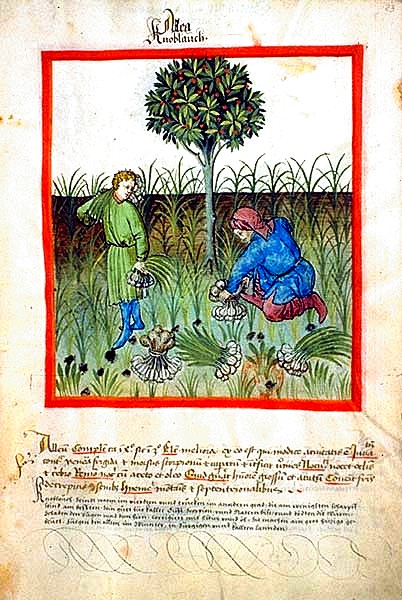In late April we planted 100 cloves of garlic from three or four different varieties. The garlic plot while small is an experiment to see whether it is possible for us to grow organic garlic successfully. The planting is a direct response to the irradiated Chinese (a staggering 77% of global production) and Argentinian product that is being sold in the major supermarket chains. That just cannot be good for you and since garlic is one crop that can be stored for 9 months and preserved so it can be used all year it has to be a worthwhile effort. Plus we cook with it almost every day.
Allium sativum is a member of the onion family and relatively easy to grow in a temperate climate preferring acid soils - okay so far at Daramalan!! Wild and cultivated garlic has been eaten and used medicinally for thousands of years, by Egyptians, Syrians and Romans. It even gets a mention in the Bible and the Talmud (not sure about the Koran). It was used to treat parasites, digestion, low energy, colds, breathing disorders and was thought of as a cure-all.
Garlic is mentioned in the Bible and the Talmud. Hippocrates, Galen, Pliny the Elder, and Dioscorides all mention the use of garlic for many conditions, including parasites, respiratory problems, poor digestion, and low energy. The Romans saw it as a cure-all.
Some studies have found garlic to have antibacterial, antiviral, and antifungal activity. It is also claimed to help prevent heart disease and cancers. When crushed garlic yields allicin, a powerful antibiotic and antifungal compound. It also contains sulphur containing compounds and various enzymes, proteins, minerals and vitamins. The sulphur containing phytochemicals responsible for the sharp flavor of garlic are produced when the plant's cells are damaged. The strong odour causes "garlic breath" (garlic is also called the 'stinking rose') and the allyl methyl sulphide "smell" is excreted through the skin. Ever sat on the Paris Metro?!!
Some studies have found garlic to have antibacterial, antiviral, and antifungal activity. It is also claimed to help prevent heart disease and cancers. When crushed garlic yields allicin, a powerful antibiotic and antifungal compound. It also contains sulphur containing compounds and various enzymes, proteins, minerals and vitamins. The sulphur containing phytochemicals responsible for the sharp flavor of garlic are produced when the plant's cells are damaged. The strong odour causes "garlic breath" (garlic is also called the 'stinking rose') and the allyl methyl sulphide "smell" is excreted through the skin. Ever sat on the Paris Metro?!!
Garlic myths and legends abound - after Satan left the Garden of Eden the smell of garlic came from his left footprint and onion from his right. Garlic cloves warded off vampires, werewolves and devils. Hindus and Jains avoid using garlic as it heats and stimulates desire and Islam views eating garlic and going straight to the mosque as inappropriate.
Whatever the myths and health benefits we will hopefully harvest 100 bulbs in early summer and have enough for our needs. All going well then there will be 1000 cloves planted in 2011 and we will supply family and friends and maybe even try a farmer's market.
Ciao.


